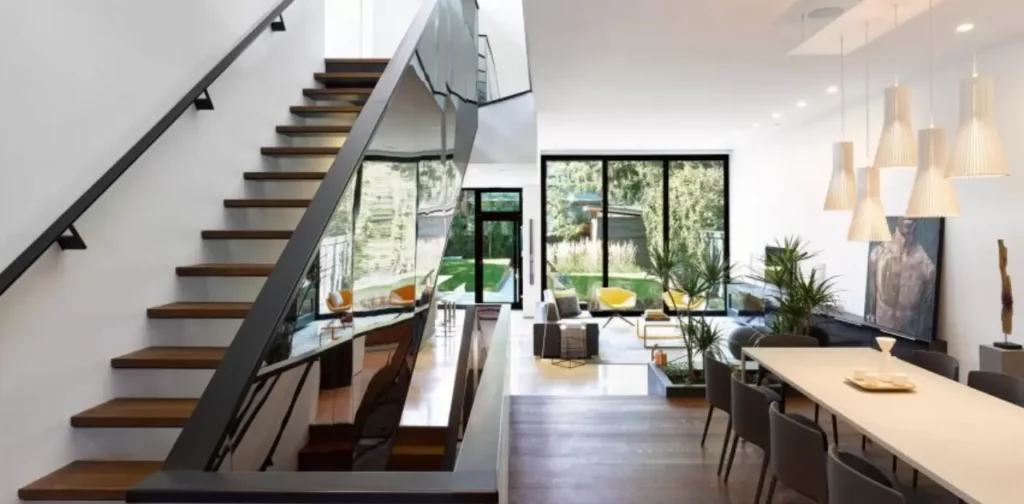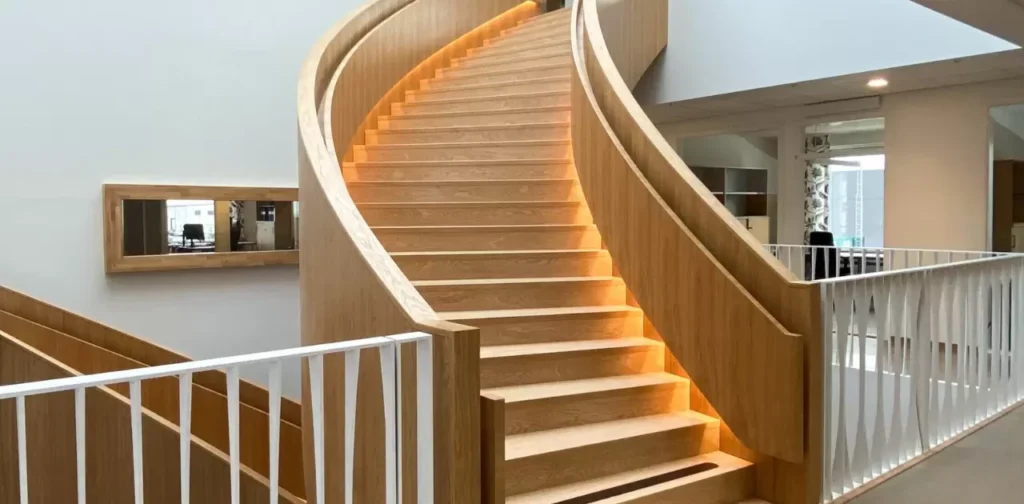Imagine a world without stairs – pure chaos. Stairs are the unsung heroes that vertically connect our lives. This article dives deep into the anatomy of a flight of stairs, unraveling the mathematical calculations behind determining the perfect number of steps for seamless ascent and descent.
What Exactly Is a Flight of Stairs?
A flight of stairs is a set of steps between two floors or landings, with the same rise (vertical height) and run (horizontal depth) for each tread without interruption. Its purpose is to provide vertical access across different levels within a building. The term flight of stairs derives from the French phrase to fly up the stairs implying a smooth uninterrupted ascent or descent.
It’s important to distinguish between steps, stairs, and stairways. A step is an individual support for the foot while climbing or descending a stairway. Stairs refer to the entire stairway or flight of steps. Meanwhile a stairway or stairwell encompasses the complete set of stairs and landings between floors.
With this foundation, let’s explore the diverse types of staircases that architects ingeniously craft.
A Kaleidoscope of Staircase Designs

Architects and designers have crafted various staircase styles to suit different spatial constraints, aesthetic preferences, and functional needs. Here are some of the most common types:
- Straight Staircase: A single continuous flight of stairs, occasionally separated by a landing or a partial turn.
- U-Shaped Staircase: Featuring two straight flights that turn 90 degrees creating a U-shape.
- L-Shaped Staircase: The stairs make a 90-degree turn creating an L-shape.
- Spiral Staircase: Treads wind around a central column or pole in a spiral pattern, creating an open and airy feel.
- Helical Staircase: Similar to a spiral staircase, but the treads are not supported by a central column.
- Winder Staircase: A variation of the L-shaped staircase, with pie-shaped or triangular steps at the turn, saving space.
- Cantilever Staircase: The treads appear to be floating, with hidden supports creating a sense of weightlessness.
- Split Staircase: Also known as bifurcated stairs, these start wide and then split into narrower flights leading in opposite directions after a landing.
The chosen design profoundly influences the number of steps required, as well as the overall aesthetic and functionality of the staircase.
Read also this: Transform Your Kitchen: Essential Planning Tips for the Perfect Layout
Unveiling the Mathematical Mastery Behind Step Calculations
While the average flight of stairs typically contains 13-16 steps this number can vary based on several factors primarily the ceiling height. Other influential factors include the riser height (vertical component), tread depth (horizontal component), and local building codes.
To calculate the approximate number of steps needed follow these steps:
- Measure the total vertical rise or ceiling height, including the ceiling drywall, upstairs floor joists, and flooring for the upper floor. Convert this measurement to inches.
- Divide the total vertical rise by the maximum allowed riser height, which is typically 7.75 inches (as per most building codes).
- Round the result to the nearest whole number to obtain the estimated number of steps required.
Here are some examples:
- For an 8-foot (96-inch) ceiling: 96 ÷ 7.75 = 12.39, rounded to 13 steps.
- For a 9-foot (108-inch) ceiling: 108 ÷ 7.75 = 13.94, rounded to 14 steps.
- For a 10-foot (120-inch) ceiling: 120 ÷ 7.75 = 15.48, rounded to 15 or 16 steps.
It is important to note that building codes also specify a maximum of 36 steps (based on a 4-inch minimum riser height) and a minimum dictated by the 7.75-inch maximum riser height in a single flight without a landing.
The Multifaceted Roles of Staircases

Beyond their primary function of vertical transportation, staircases serve multifaceted roles that shape their design:
- Space Optimization and Visual Appeal: Well-designed staircases can optimize floor space while adding visual interest and architectural flair to a building.
- Accessibility Across Multiple Levels: Staircases make different floors and levels accessible, ensuring smooth vertical circulation within a structure.
- Architectural Showpieces and Home Aesthetics: In residential settings, staircases can be designed as stunning architectural focal points that complement the overall aesthetics of the home.
- Potential Fire Escape Routes: In some buildings, staircases may serve as designated fire escape routes, requiring compliance with additional safety codes and regulations.
- Accommodating Varying Mobility Needs: Staircase designs must consider the mobility requirements of all potential users, including those with physical disabilities or limitations.
Read also this: How To Buy A Foreclosed Home In California?
Design Considerations for the Perfect Flight
Creating the perfect flight of stairs involves carefully balancing various design considerations:
- Local Building Codes and Regulations: Familiarize yourself with local building codes and regulations that govern staircase construction, including minimum and maximum dimensions, safety features, and accessibility requirements.
- Public vs. Private Building Requirements: Building codes may differ for public and private structures, with stricter guidelines often applied to commercial or public buildings.
- Aesthetic Preferences and Home Styles: In residential settings, the staircase design should complement the overall architectural style and aesthetic preferences of the homeowners.
- Safety Features: Incorporate essential safety features such as guardrails, handrails, banisters, and non-slip treads to ensure secure ascent and descent.
- Sufficient Space at Top and Bottom Landings: Allocate adequate space at the top and bottom of the staircase for safe navigation and maneuvering.
By carefully considering these factors, you can create a staircase that seamlessly blends form function and safety becoming a functional masterpiece in your building or home.
Frequently Asked Questions
How many stairs are in a flight of stairs?
The average flight of stairs typically contains 13-16 steps. However, this number can vary based on factors such as ceiling height, riser height, tread depth, and local building codes.
How many steps should be on one floor?
The number of steps on one floor depends on the ceiling height. For a standard 8-foot (96-inch) ceiling, you would typically have around 13 steps. For a 9-foot (108-inch) ceiling, it would be around 14 steps and for a 10-foot (120-inch) ceiling you’d need approximately 15-16 steps.
What is the maximum number of steps allowed in a single flight?
Most building codes specify a maximum of 36 steps in a single flight of stairs without a landing, based on a minimum riser height of 4 inches.
What is the minimum number of steps in a flight?
There is no definitive minimum number of steps, as this is determined by the maximum allowed riser height, which is typically 7.75 inches. The minimum number of steps would be calculated based on the total vertical rise divided by this maximum riser height.
Can I have a different number of steps than the calculated estimate?
While the calculations provide a good estimate, you may choose to have a slightly different number of steps based on your specific design preferences or spatial constraints. It is essential to ensure that you comply with local building codes and regulations regarding minimum and maximum riser heights and tread depths.
By the end of this article, readers will have a comprehensive understanding of what constitutes a flight of stairs, the factors influencing step count, and the design considerations for creating a seamless and visually stunning staircase experience.
Conclusion
Determining the ideal number of steps in a flight of stairs is a delicate balance between mathematical calculations, building codes, and design considerations. From ceiling heights and riser dimensions to aesthetic preferences and accessibility needs, each factor plays a crucial role in shaping the perfect staircase.
By understanding the intricacies of staircase design and adhering to local regulations, you can create a functional and visually stunning staircase that not only connects floors but also enriches the overall architectural experience.
Remember the key to a successful staircase lies in striking the right balance between design safety and functionality. Do not hesitate to consult with professionals who can guide you through the process ensuring that your dream staircase becomes a reality.
By the end of this article readers will have a comprehensive understanding of what constitutes a flight of stairs the factors influencing step count and the design considerations for creating a seamless and visually stunning staircase experience.











